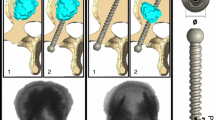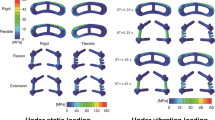Abstract
The rigidity of a pedicle screw implant is a critical biomechanical variable in lumbar spinal fusions. Sufficient rigidity is required for integration of bone grafts and to promote healing. Osteopenia, stress shielding, and compensatory hypermobility have been described as consequences of excessive rigidity. Little is known about the biomechanical characteristics of “semirigid” compared to “rigid” implants. A new implant, whose rigidity can be varied by selection of different implant components, was tested in vitro under well-defined loading conditions. The three-dimensional load-displacement behavior of all lumbar vertebrae involved in or adjacent to the two-level fusion was evaluated for two fusion modifications: bilateral rigid and bilateral semirigid. Cyclic fatigue loading was subsequently carried out under realistic conditions and motion testing repeated. The rigid device reduced the motion of the L3–4 transfixed segment in the primary movement planes by 87.3% with respect to the intact spine value in flexion/extension (FE), 86.3% in lateral bending (LB), and 76.8% in axial rotation (AR). The semirigid device achieved a reduction in motion of 79.6% (FE), 82.7% (LB), and 51.7% (AR). The semirigid implant was particularly easy to insert, because no bending of rods or plates was necessary. The implants showed no loosening or breakage after the fatigue testing. The results are compared to other available systems and the underlying biomechanics discussed.
Similar content being viewed by others
References
Abumi K, Panjabi MM, Duranceau J (1989) Biomechanical evaluation of spinal fixation devices. III. Stability provided by six spinal fixation devices and interbody bone graft. Spine 14: 1249–1255
Angst M, Winter M, Lang MC (1993) Dorsal tension band stabilization for the lumbar spine analyzed in vitro (abstract). J Biomech 26:817
Blumenthal S, Gill K (1993) Complications of the Wiltse pedicle screw fixation system. Spine 18:1867–1871
Dalenberg DD, Asher MA, Robinson RG, Jayaraman G (1993) The effect of a stiff spinal implant and its loosening on bone mineral content in canines. Spine 18:1862–1866
Farey ID, McAfee PC, Gurr KR, Randolph MA (1989) Quantitative histologic study of the influence of spinal instrumentation on lumbar fusions: a canine model. J Orthop Res 7:709–722
Gaines RW, Carson WL, Satterlee CC, Groh GI (1991) Experimental evaluation of seven different spinal fracture internal fixation devices using nonfailure stability testing. Spine 16:902–909
Galante JO (1967) Tensile properties of the human lumbar annulus fibrosus. Acta Orthop Scand Suppl 100: 30–32
Goel VK, Weinstein JN (1990) Biomechanics of the spine: clinical and surgical perspective. CRC, Boca Raton
Goel VK, Nye TA, Clark CR, Nishiyama K, Weinstein JN (1987) A technique to evaluate an internal spinal device by use of the Selspot system: an application to the Luque closed loop. Spine 12:150–159
Goel VK, Lim TH, Gwon J, Chen JY, Winterbottom JM, Park JB, Weinstein JN, Alm JY (1991) Effects of rigidity of an internal fixation device. A comprehensive biomechanical investigation. Spine 16: S155-S161
Graf H (1992) Instabilité vertébrale. Traitement à l'aide d'un système souple. Rachis 4:123–137
Grevitt MP, Gardner ADH, Spilsbury J, Shackleford IM, Baskerville R, Pursell LM, Hassaan A, Mulholland RC (1995) The Graf stabilisation system: early results in 50 patients. Eur Spine J 4:169–175
Grob R, Grosskopf D (1993) Spondylolisthesis by spondylosis — indications and results: data from a study of 36 cases. Actualités Vertébrale 1: 5–7
Gwon JK, Chen J, Lim TH, Han JS, Weinstein JN, Goel VK (1991) In vitro comparative biomechanical analysis of transpedicular screw instrumentations in the lumbar region of the human spine. J Spinal Disord 4:437–443
Heggeness MH, Esses SI (1991) Classification of pseudarthroses of the lumbar spine. Spine 16:S449-S458
Johnston II CE, Ashman RB, Baird AM, Allard RN (1990) Effect of spinal construct stiffness on early fusion mass incorporation: experimental study. Spine 15:908–912
Kabins MB, Weinstein JN, Spratt KF, Found EM, Goel VK, Woody J, Sayre HA (1992) Isolated L4-L5 fusions using the variable screw placement system: unilateral versus bilateral. J Spinal Disord 5:39–49
Krag MH (1991) Biomechanics of thoracolumbar spinal fixation. Spine 16:S84-S99
Lorenz M, Zindrick M, Schwaegler P, Vrbos L, Collatz MA, Behal R, Cram R (1991) A comparison of single-level fusions with and without hardware. Spine 16:5455-S458
Luque ER, Rapp GF (1988) A new semirigid method for interpedicular fixation of the spine. Orthopedics 11:1445–1450
Magerl F (1982) External skeletal fixation of the lower thoracic and the lumbar spine. In: Uhthoff HK, Stahl E (eds) Current concepts of external fixation of fractures. Springer, New York, pp 353–366
McAffee PC, Farey ID, Sutterlin CE, Gurr KR, Warden KE, Cunningham BW (1989) Device-related osteoporosis with spinal instrumentation. Spine 14:919–925
McAfee PC, Farey ID, Sutterlin CE, Gurr KR, Warden KE, Cunningham BW (1991) The effect of spinal implant rigidity on vertebral bone density: a canine model. Spine 16:S190-S197
Nagel DA, Kramers PC, Rahn BA, Cordey J, Perren SM (1991) A paradigm of delayed union and nonunion in the lumbosacral joint: a study of motion and bone grafting of the lumbosacral spine in sheep. Spine 16:553–559
Nye TA (1985) The effect of stabilization upon the kinematics and ligamentous strains of the entire lumbar spine. Thesis, University of Iowa
Panjabi MM (1988) Biomechanical evaluation of spinal fixation devices. 1. A conceptual framework. Spine 13:1129–1134
Panjabi MM, Kuniyoshi A, Duranceau J, Crisco JJ (1988) Biomechanical evaluation of spinal fixation devices. II. Stability provided by eight internal fixation devices. Spine 13:1135–1140
Pfeiffer M, Griss P, Goel VK (1996) DDS: the Marburg experience. In: Szpalski M, Gunzburg R, Spengler DM, Nachemson A (eds) Instrumented fusion of the degenerative lumbar spine: state of the art, questions and controversies. Lippincott-Raven, Philadelphia, pp 185–199
Pintar FA, Cusick JF, Yoganandan N, Reinartz J, Mahesh M (1992) The biomechanics of lumbar facetectomy under compression-flexion. Spine 17:804–810
Puno RM, Bechtold JE, Byrd JA, Winter RB, Ogilvie JW, Bradford DS (1991) Biomechanical analysis of transpedicular rod systems. Spine 16:973–980
Smith KR, Hunt TR, Asher MA, Anderson CH, Carson WL, Robinson RG (1991) The effect of a stiff spinal implant on the bone-mineral content of the lumbar spine in dogs. J Bone Joint Surg [Am] 73:115–123
Strauss PJ, Novotny JE, Wilder DG, Grobler LJ, Pope MH (1994) Multidirectional stability of the Graf system. Spine 19:965–972
White AA, Panjabi MM (1990) Clinical biomechanics of the spine, 2nd edn. Lippincott, New York
Author information
Authors and Affiliations
Rights and permissions
About this article
Cite this article
Pfeiffer, M., Hoffman, H., Goel, V.K. et al. In vitro testing of a new transpedicular stabilization technique. Eur Spine J 6, 249–255 (1997). https://doi.org/10.1007/BF01322447
Received:
Revised:
Accepted:
Issue Date:
DOI: https://doi.org/10.1007/BF01322447




